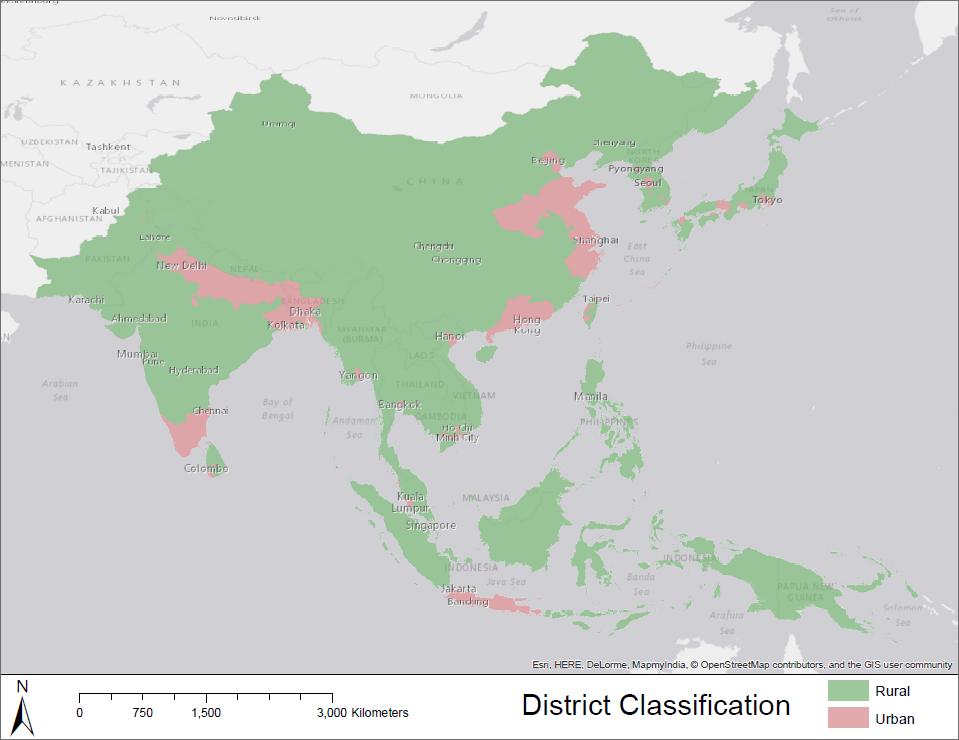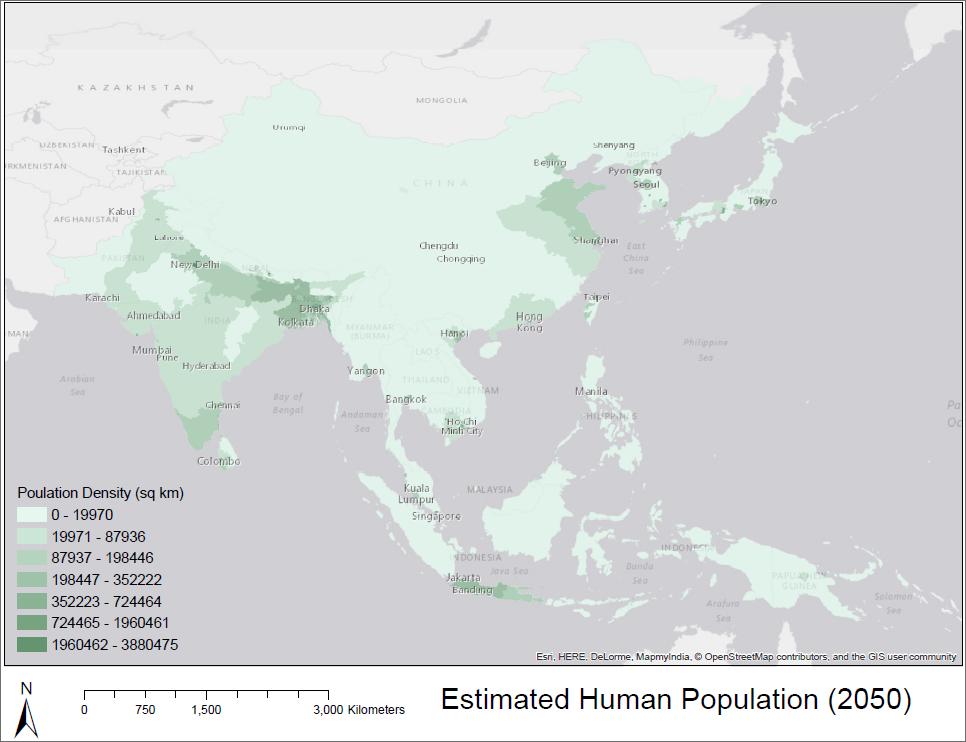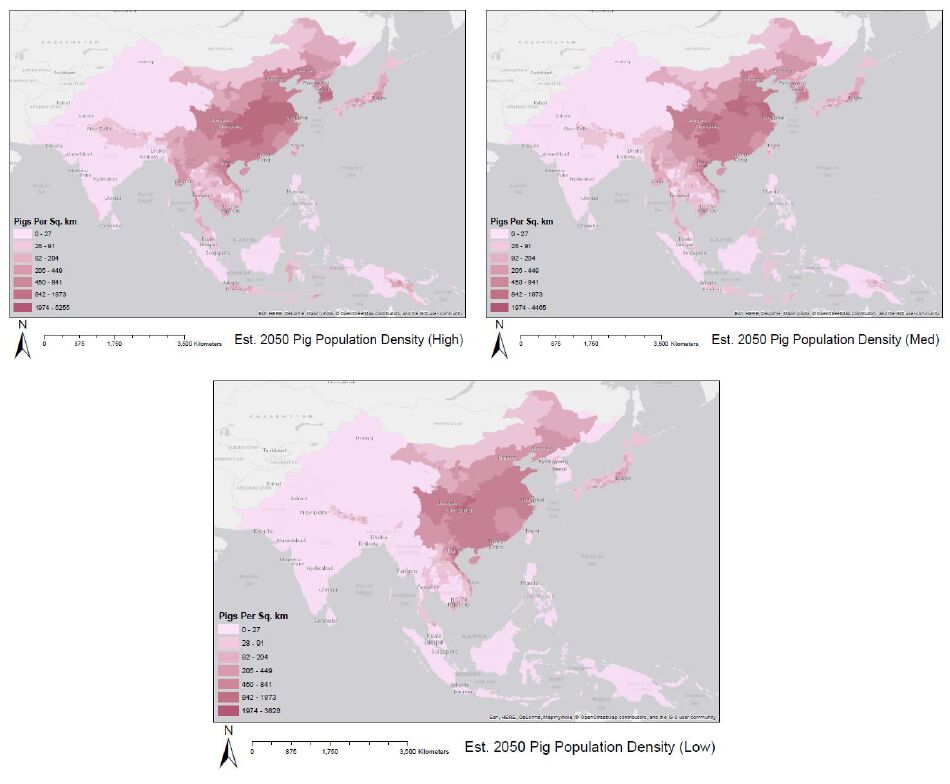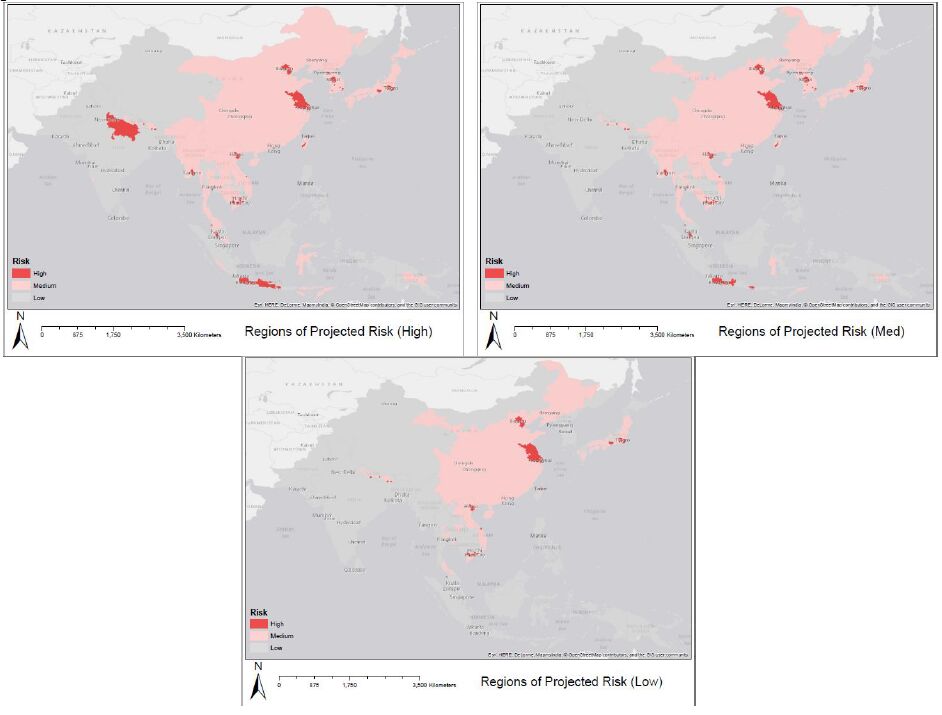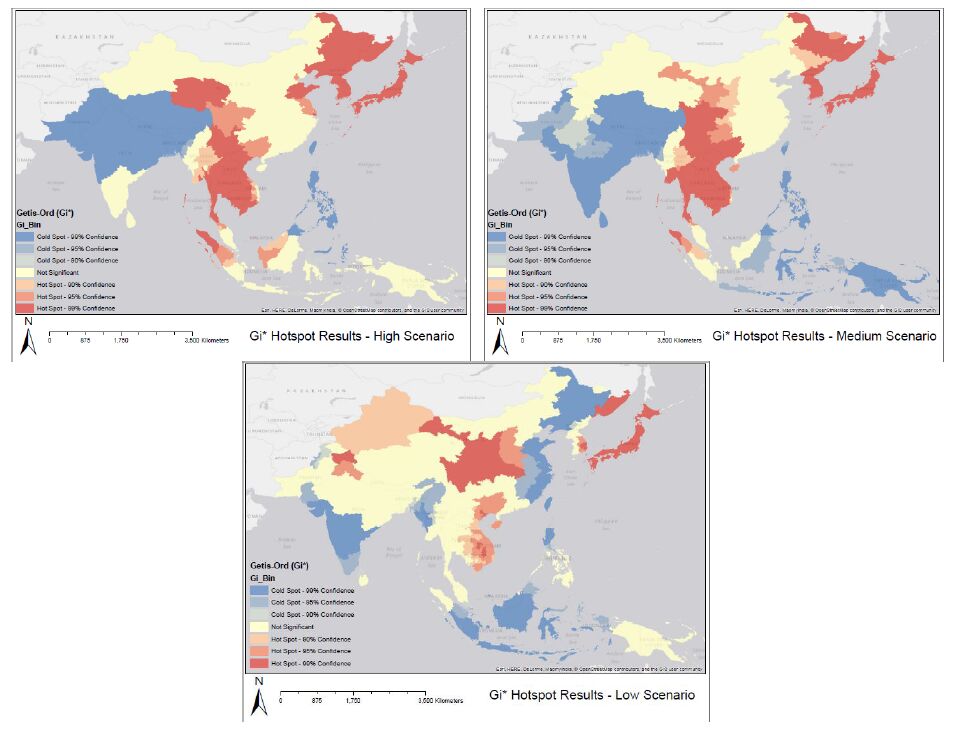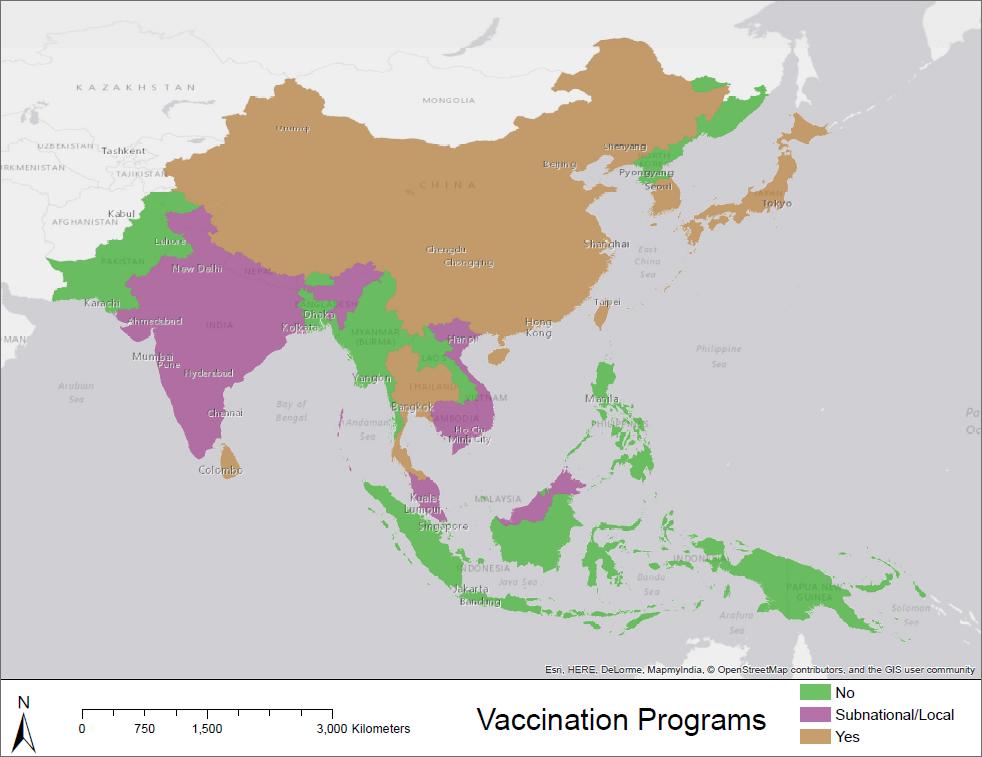1. Introduction
Japanese Encephalitis (JE) is the leading cause of viral encephalitis in Asia [1,2]. It is estimated that approximately 67,900 cases occur annually [3]. The case fatality rate is 20-30% and 30-40% of survivors suffer from permanent neurological sequelae [3]. The disease is primarily acquired by children less than 15 years of age and is historically more common in rural and agricultural areas [1,2,3].
Confirmed cases of JE are reported to the World Health Organization through the programme for vaccine-preventable diseases (http://apps.who.int/immunization_monitoring/en/). Surveillance is absolutely necessary to guide immunization programs, target surveillance resources, set priorities, and can serve as an early warning system for identifying public health emergencies [4]. However, most human cases of JE are asymptomatic and go unreported, making the spatial distribution of the virus difficult to estimate.
The [4] estimates that approximately 1 in 250 of those who acquire the JE virus display encephalitis symptoms. For those that do experience disease, there is significant variation in health seeking behaviours across Asia, which distorts the sensitivity of disease surveillance systems. Factors such as the structure of the health care system (centralized or not), physical access to health care, propensity to adopt traditional and/or care services outside of the government system all vary across Asia and merge to obscure understanding of the disease burden due to JE. For example, [5] noted that many people in Nepal prefer traditional healers/medicine over hospitals, resulting in many unreported cases. [5] also mentioned that this preference for traditional healers was more prominent among poor and disadvantaged sectors of the population. There is therefore need to examine not only the reported cases of disease, but also the distribution of disease risk factors when estimating risk, developing health policy, and anticipating future changes.
There are several major contributing factors that lead to high-risk areas for JE. Firstly, landscape factors play an important role in vector-borne disease transmission. Increased area dedicated to land-use types that contribute to vector habitat promote virus transmission and risk to humans. Other landscape characteristics, such as fragmentation and heterogeneity, can also increase risk of vector-borne disease [6]. Secondly, susceptible populations mixed with pig populations are strongly linked to JE risk. Pigs are considered to be an amplifying host for the JE virus. If a pig is infected with the virus, the probability that there will be infected mosquitoes in their vicinity is significantly increased. Age is also linked to JE, as the virus is typically associated with disease in children for areas where it is endemic. However, where childhood immunization programs exist, risk is approximately equal for adults and children [7,8].
The Morbidity and Mortality Weekly Report conducted by [3] summarized the status of JE surveillance programs in risk areas. The report concluded that as of 2012, 10 of 25 countries with JE risk conducted nation-wide surveillance programs. They reported that six countries do not conduct any form of surveillance. The true incidence of JE is largely unknown due to the lack of sufficient surveillance and diagnostic laboratory testing in many countries [2,4].
Additional information is required to compensate for limitations in surveillance data to inform JE preparedness and response planning. In this study, we propose a method that compensates for under-reporting using demographic trends as a forecasting tool. We also estimate potential distribution of pig population density in Asia using livestock head count data from the United Nations’ Food and Agricultural Organization (FAO). By estimating where people are in the near future, and where amplifying host are, we can identify areas where there may be more susceptible individuals and thus areas of higher risk for JE.
2. Background
2.1. The Japanese Encephalitis Virus
The JE virus (JEV) is a Flavivirus transmitted via mosquitoes. The primary vector of JEV is from the genus Culex, although other mosquitoes are also known to carry the virus [9]. Rice agriculture areas provide ideal habitat for Culex mosquitoes, and thus risk of acquiring the virus tends to increase with proximity to paddy fields [10,11]. [12] estimated that area dedicated to rice agriculture in Asia increased by 22% during the period 1963-2003, which has directly contributed to habitat expansion of Culex mosquitoes.
Wild birds and domesticated pigs are the primary hosts of the JEV. Wading birds from the family Ardeidae (herons, bitterns, and egrets) are a natural reservoir for the virus. These birds require shallow water bodies as feeding grounds [13] and thus frequent areas dedicated to rice agriculture. Species from the family Suidae, which include domesticated pigs and wild boar, are the main amplifying hosts of JEV [4,10,14]. When pigs are infected with JEV, they are able to infect many additional mosquitoes. Increasing area dedicated to rice agriculture and the growing pork industry in Asia presents a growing concern for JE transmission in the near future. The distribution of risk factors related to pig husbandry, mosquito life cycle development and habitat, and interactions between hosts and vectors is extremely difficult to track over large areas. As such, this paper focuses on human and pig population trends as a way to forecast future changes of JE in Asia.
2.2.The State of Japanese Encephalitis in Asia
JE was first identified in 1871 and the first recognized epidemic occurred in Japan in 1924 [15]. Since then, the geographic distribution of JE has been expanding [15]. [15] suggested that a changing landscape, involving deforestation and increased agricultural area (especially rice agriculture and pig farming), has promoted the spread of the disease. These landscape variables are associated with a population growth and change. Figure 1 displays the current geographic distribution of JE [2,3].
2.3.Japanese Encephalitis in Urban Areas
[16] recently demonstrated how JE is becoming increasingly urban. For example, urbanized areas in the area of the National Capital Territory of Delhi, India provide sufficient breeding habitats for Culex mosquitoes that transmit the JE virus [16]. The presence of migratory Ardeidae birds and pig domestication in these urban settings has amplified JE transmission. [16] was the first to identify cases of JE in the Delhi area and also provided evidence that JE is becoming increasingly an urban, rather than just a rural issue.
[17] stated that rapid human population growth leading to crowding and poor sanitation has resulted in the proliferation of Aedes mosquitoes, which have the potential to carry the dengue virus (although this disease can be endemic within a human population without any animal reservoirs). These types of urban landscape characteristics have led to increased risk of vector-borne diseases in urban areas. It is for these reasons that this study eliminates differentiating between rural and urban area and risk of JE. We do however, differentiate between rural and urban population growth rates in Asia, as urbanization is an increasingly important process transforming exposure opportunities in Asia.
2.4.Land-use & Landcover Change
The population in Asia is expected to increase from 4.342 billion in 2012 to 5.164 billion by 2050 [18]. Land-use change and the expansion of agriculture, the key driving forces of JE transmission are expected to intensify as population increases [19]. [19] stated that during the period 1990-2008, agricultural land increased in area by over 8% in Southeast Asia. Pig-farming is also intensifying in Asia. [10] estimated that between 1990 and 2005, Cambodia, China, South Korea, Laos, Myanmar, Nepal, the Philippines, Sri Lanka, Thailand, and Vietnam all experienced increased pork production by between 12% and 381%. Such environmental factors, as well as population increases, will undoubtedly lead to an increased amount of JE cases unless otherwise managed.
2.5.Study Objectives
The objectives of this paper are to;
• Develop forecasts of populations vulnerable to JE across Asia for 2050
• Develop forecasts under high, medium and low scenarios of amplifying hosts for JE across Asia for 2050
• Identify locations where overlapping risk reservoirs, host populations, and facilitating contextual factors are present in 2050 given current knowledge which we aim to use to both present a methodology for anticipating future change in emerging diseases, and specific to JE, anticipating future patterns of risk for data-driven health policy formulation and disease management planning.
3. Materials and Method
3.1.Study Area
The study area includes all countries where JE has been identified. This includes most countries in South Asia, East Asia, and Southeast Asia as shown in Figure 1.
3.2.Data
Administrative boundaries were obtained from www.diva-gis.org [20] and were used for district-level analyses.
Two sets of population data were obtained. The first set was obtained from www.worldpop.org.uk and is presented as people per pixel for the year 2015 and is adjusted to match the UN Population Division estimates. The gridded population data set was use to estimate districts that were predominantly rural or urban, assuming that higher population densities occur in more urbanized areas.
The second population set was obtained from GeoHive at http://www.geohive.com/ [21]. Geo- Hive data were retrieved at one level below the national level for each country’s most recent census and spatially joined to the administrative boundaries.
The United Nations World Urbanization Prospects project (UN WUP 2014) estimated rural and urban growth rates for five year intervals for each country (http://esa.un.org/unpd/wup/CD-ROM/). These growth rates were used to project district-level populations until the year 2050, this method will be discussed further in Section 3.4.
Two pig population datasets were obtained from the Food and Agriculture Organization of the United Nations (FAO). Yearly pig head counts for the period 1961-2012 were obtained for each country from the ‘Live Animals’ database [22]. Data from this database is only available at the country level and was not available for every country in the study area (Figure 1). A gridded livestock density map for pigs for the year 2005 was obtained from http://www.fao.org/ag/againfo/resources/en/glw/GLW_dens.html [23]. The livestock density raster was used to determine district-level pig populations, which was not available using 2013 data from the ‘Live Animals’ database.
Landcover data derived from MODIS satellite imagery was obtained from the Global Land Cover Facility (GLCF) at http://glcf.umd.edu/data/lc/. The GLCF classifies MODIS imagery into 16 landcover types at a 5 arc-minute (0.08333 degrees) spatial resolution [24]. These landcover types were used to define districts as being either rural or urban so that appropriate growth rates could be applied.
3.3.District Classification
[25] noted that “urban means nonagricultural”. Regions that exhibit high population densities may still focus on a rural way-of-life (i.e. agricultural activities), especially in Asia where many countries have rural populations of over 50% of the total population [26]. Therefore, to classify districts as being predominantly urban or rural, landcover characteristics from [24] were considered.
For a district to be classified as urban, two conditions were to be satisfied. The first condition required population densities to exceed 500 persons per square kilometre and that the majority pixel count was not ‘croplands’ as classified by [24]. The second condition stated that the majority pixel count was ‘Urban and built-up’ as classified by [24] within district boundaries.
For a district to be classified as being predominantly rural, it failed to meet the criteria of being defined as urban. Landcover characteristics were also considered, and if a district contained a majority of pixels classified as ‘croplands’ [24], then that district was classified as rural. Final district classification is shown in Figure 2.
3.4.Human Population Projections
The rate of urban population growth and rural population growth often differs. According to [27], the urban growth rate for South-central Asia and South-eastern for the period 1950-2000 was 3.34% and 4.02%, respectively. The rural population growth rates for these two regions were 1.84% and 1.53%, respectively [27]. For studies in population projection at a subnational level, it is thus necessary to specify rural and urban areas. However, the distinction is not always straightforward. In many Asian countries, a high population density may not always suggest that a region is dominated by an urban lifestyle. Many Asian countries are still characterized by a rural way of life, even though populations may be high [28]. In this study, we use the most recent rural and urban growth rates as determined by the [18] and apply them to districts classified in Section 3.3.
Five year average growth rates from WUP 2014 were used to project future population values. Population values were estimated for each 5 year interval’s end year, which were then used to estimate the next interval’s value. The geometric population growth model was used to estimate future populations as shown in Equation 1.
Where PopF is the year for the estimated population, PopC is the value of the population for the districts most recent census, r is the population growth rate from UN WUP 2014, and T is the number of years between PopF and the country’s last census year.
Based on the classification of each district being predominantly urban or rural, each country’s most recent census and population growth rates from the UN’s WUP 2014, population at the district level was calculated for the year 2050. We estimated that population in the study area increased from ≈ 3.9 billion for the year 2015 to ≈ 4.5 billion for the year 2050. Considering that the study area comprises most, but not all of Asia, these estimates are roughly in line with [18] estimates for the study area.
3.5.Pig Population Projections
Pig population data in raster format for the year 2005 were used to estimate district-level values. A zonal statistics summary was performed on this raster dataset and used to estimate pig population proportions at the district-level (i.e. zonal sum in district divided by country total). Tabular data from the FAO’s ‘Live Animals’ database for each year for the period 1961-2013 at the country level were then multiplied by district-level proportions devised from the raster dataset.
Data for all countries in the study area were not available from the FAO’s Live Animals database. Countries for which pig headcount data was obtained were; Bhutan, Brunei, Cambodia, China, Japan, Hong Kong, Macao SAR, Taiwan, North Korea, India, Indonesia, Laos, Malaysia, Myanmar, Papua New Guinea, South Korea, Sri Lanka, Thailand, Timor-Leste, and Vietnam.
At the country-level, pig livestock data from the FAO were used to estimate future values in low, medium, and high scenarios. Projections for the year 2050 were done using the ‘Forecast’ package in R, which is used for analyzing univariate time series data. Forecasts were calculated with a 75 percent prediction interval. The upper bounds, mean, and lower bounds of the prediction interval were used for high, medium, and low scenarios, respectively. The forecast function fits an exponential smoothing state (ETS) model to the time series data to predict future values [29]. Country-level pig projections were then allocated to district administrative boundaries according to their 2005 proportions.
3.6.Highly Vulnerable Regions
Highly vulnerable regions (HVR) for JE in 2050 were identified in two ways. Firstly we mapped the spatial overlap of population and pig populations. Population changes were categorized as either declining (% change < 0), stable (%change 0-5), low (%change 6-10), moderate (%change 7-20), and high (%change > 20). Pig populations were categorized using the same classification, and maps of growth classes were created and used to identify highly vulnerable regions.
Additionally, the percent changes in the ratio of pig populations to human populations were calculated and mapped. Spatial analysis of the percent change was used to derive hotspots of significant change using the local Getis-Ord spatial statistic. The local Getis-Ord statistic (Gi (d)) [30] takes a moving average of a numeric variable x within a spatial neighbourhood defined by a spatial weight matrix wij (d) (where d is the maximum distance at which nearby points are included as neighbours) as:
|
Gi(d)=∑jwij(d)xjn∑j=1xj
|
(2) |
over the total sum of
x. In practice
Gi (d) is defined as a standard normal deviate, and therefore can be interpreted as a z-score. We employ the
Gi (d) statistic to identify significant spatial clusters where the relationship between pigs and people are expected to change.
Results of HVR mapping were interpreted relative to contextual variables relevant for JE risk, including landcover classification, vaccination status of populations, and the current distribution of JE incidence.
4. Results
4.1.Human Population Change in Asia
Figure 3 shows our estimated population density, using urban/rural growth rate distinction, for the year 2050. Figure 4 shows our estimation of population change. While large regions of rural China are projected to experience population loss which dominate the map, urban areas in southeast Asia, and southern India are expected to experience positive change in population by 2050, reflecting the regional trend toward urbanization, described by the [18].
4.2.Pig Population Change in Asia
Figure 5 displays our estimated pig projection and distribution at the district-level for the year 2050 under the three forecasted scenarios. Here, we see commonalities between the three forecasts. Central China, and pockets of Nepal, northern India, Japan, and North Korea exhibit high densities in all three scenarios.
4.3.Highly Vulnerable Regions in Asia
Maps of pig populations and human populations in 2050 were combined to identify regions that exhibit high human population densities (> 1 000 per sq. km) and high pig densities (> 50 per sq. km) for the year 2050 in Figure 6. Parts of eastern coastal China and urban regions in Southeast Asia are highlighted as particularly vulnerable in all three scenarios.
The relationship between pigs and people is expressed in Figure 7 as the percentage change in the ratio of pigs to people. The Getis-Ord statistic highlights hotspots (significant increases) in pig:human populations and coldspots (significant decreases) based on the local Getis-Ord analysis.
5. Discussion
This study considers potential population trends and JEV amplifying host projections at the districtlevel in order to estimate regions of potential risk for acquiring Japanese Encephalitis. By projecting future spatial patterns of susceptible human populations and risk factors (pigs) we highlight regions that should be of special interest for disease intervention strategies.
Figure 6 displays regions where pig population densitiesand human population densities are expectedto be high based on our estimations. It should be noted that these maps do not accountfor vaccination programs (Figure 8) and countries that are well-developed such as Japan may not be of particular risk.
Figure 7 highlights regions in whichpig populations (underthree different scenarios) and human populations are estimated to increasesignificantly by the year 2050. Figure 8 displays the status of immunization programs at the country level [34]. Regions depicted in green and pink either have no immunization program or a program that operates at sentinel sites.Many regions that are highlighted as high risk in Figure 7 and Figure 6 overlapwith regions depictedin Figure 8 as havingno immunization strategy.Because disease reportingis required for diseases at a nationalscale it is important to examine sub-national trends over large areas to reflect the underlying dynamicsof the disease processes. Here we have focused on some key variables of interest in order to map patternsof risk and risk change over time.
However, the transmission cycle of JE is incredibly dynamic; it is dependent on the presence of vector breeding habit, agricultural practices, climate, and proximity of the population to agricultural areas as well as various social determinants. The number of JE cases within a country is also dependenton the presence of vaccination programs, the frequency and distribution of these programswithin the country (i.e. located in rural vs. urban area), and effective surveillance. Future large-area mappingefforts may take into consideration some of the main JE driversat a more granular level of spatial detail such as land-use change, paddy areas, population movements, and pig husbandry. Examples of this approachin Nepal [3132] have shedlight on the regional distribution of risks
, howeverobtaining detailed data for such variables over large areas at granulargeographies remains a significant challenge.
Countriesin Asia are also at different stagesof development. [10] suggested that incidence of JE will increase mainly in low-incomeareas. Countries such as Cambodia, Laos, and Myanmarwill likely see JE outbreaks in the near future due to increasesin irrigated rice agriculture and pig rearing [10].
For example, during the period 1990-2005 Myanmarexhibited an increaseof 47% in rice agriculture area as well as an increaseof 381% in pork production [10]. [3] stated that Laos and Myanmar do not have JE immunization programs in place and that Cambodiaonly conducts surveillance in three of its twenty-three provinces. Considering these factors, we might expect that the incidence of JE may be greater in these countries than the current incidence as calculated by [2]. In contrast, incidence may decrease in regions where vaccination programs are in their early stages. Recent progress in JE prevention has caused increased awareness of the disease, funding, and the availability of improved vaccines, although only in more developed countries [3].
5.1.Limitations
The distinction between urban and rural districts is not always a dichotomy. [25] highlights the difficulties with this distinction. In this study, we choose to assign districts to one of these classes based off of landscape and population characteristics in order to project future populations at the district-level. The aim of this was to obtain fine-scale estimations of susceptible human populations.
This study is hindered by the quality of data used for analysis. We used the best available data to estimate potential trends and distributions of susceptible populations as well as the virus’s host. Using livestock data for the period 1961-2013 to project future trends is not always straightforward and there is much uncertainty in these estimations. We have attempted to account for this uncertainty by forecasting pig populations under three scenarios using the upper and lower bounds of a prediction interval. Pig farming is also highly contingent on cultural factors that may not be represented in the data. For example, pig farming in Nepal has significantly increased after the year 1950 due to changing religious views and the tourism industry [33]. Thus, the data shows an upward trend that may stabilize in the near future. However, these relationships are incredibly difficult to map at such a large scale and are beyond the scope of this study. Also, we show how pig populations are expected to decline in India. This may not actually be the case and may be due to low-quality of data obtained by the FAO. It should be noted that pig population estimations were conducted to the best of our knowledge using the best data available.
Land-use and landcover change plays a prominent role in the transmission of vector-borne diseases. This study did not focus on land-use and landcover change as it was beyond the scope of this study. There are many small-scale characteristics that contribute to mosquito populations, which are not visible from large-scale remotely-sensed data such as [24]. For example, [34] found that certain species of Culex mosquitoes are abundant in urban areas of India and suggested that control measures should equally focus on urban and rural areas.
6. Conclusion
[4,35] recommends that immunization is the most effective measure for preventing JE and should be extended to regions where JE is a public health problem. For many countries, resource constraints prevent the implementation immunization programs [3]. This study attempts to identify regions with high susceptible human populations and virus host populations. If regions with a high number of cases are identified, this may warrant increased attention for risk surveillance in this region.
This study examines disease risk factors at a large scale; however, many changes are occurring at a much smaller scale. For example, pig farming in Nepal is increasing due to the reduction of cultural biases against pigs [33] increasing the number of amplifying hosts in this region. It is evident that much work is needed at a smaller scale to fully understand the spatial dynamics of JE on a larger scale.
Pigs are involved in the transmission of other zoonotic diseases, such as Streptococcus suis, which can cause meningitis and other serious symptoms [36]. Using methods presented in this study, it is also possible to highlight regions where interventions on other such diseases should be focused.
Although this study highlights regions where there could be high increases in both human and pig populations, we do not discourage national-level interventions to prevent JE in other regions in Asia. We attempt to highlight regions that may be of importance in order to appropriate resources to combat JE in the case that resources are limited.
Acknowledgments
The authors would like to acknowledge researchers at the National Zoonoses and Food Hygiene Research Centre in Kathmandu, Nepal.
Conflict of Interest
The authors declare that they have no conflicting interests that influence, or could be perceived as influencing, the work presented in this study.










 DownLoad:
DownLoad: 